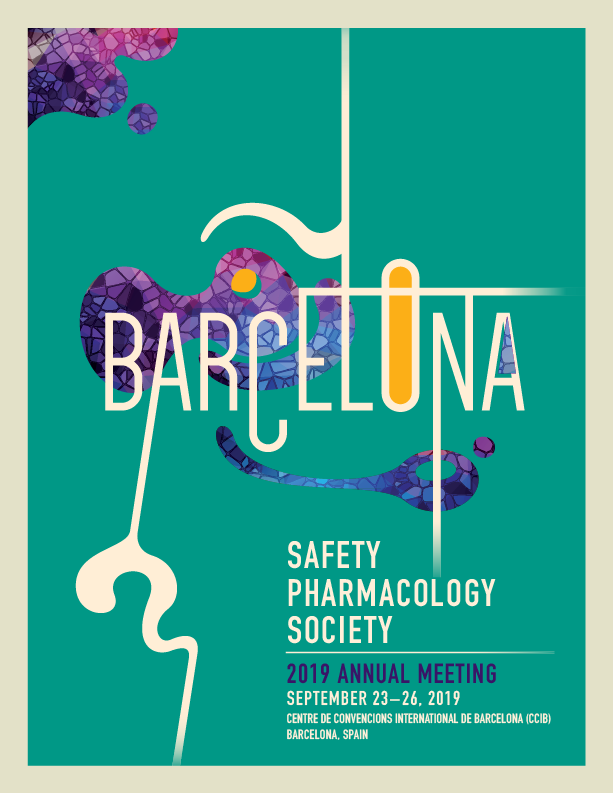- Home
- SCAP test publications
SCAP test publications
Database and peer-reviewed papers :
- 9 -
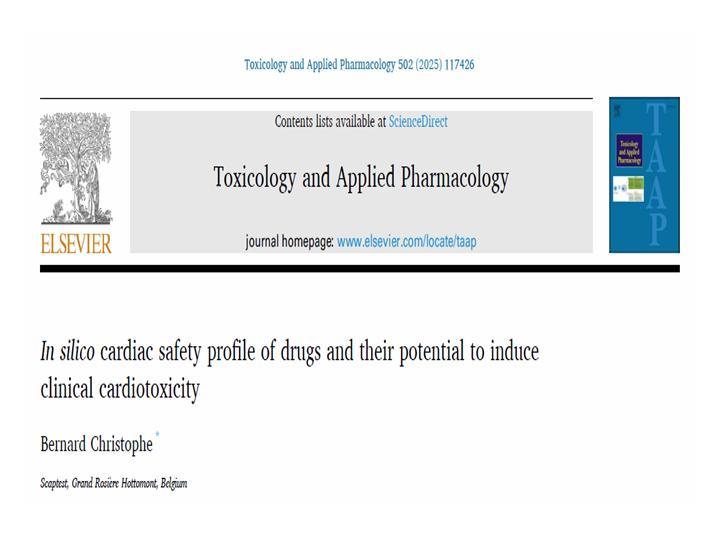
Christophe B. (2025)
In silico cardiac safety profile of drugs and their potential to induce clinical cardiotoxicity
Toxicology and Applied Pharmacology, 502, 117426
During the cardiac safety pharmacology decision-making process, a precise evaluation of the proarrhythmic liabilities of new drug candidates is essential to prevent serious side effects like torsade de pointes (TdP), which could result in sudden death. Based in part on in silico reconstruction of the human ventricular cardiomyocyte action potential (AP), the Comprehensive in vitro Proarrhthymia Assay (CiPA) initiative aims to achieve this goal. Because it is based on a significant amount of human data, the O'Hara-Rudy dynamic model is the first algorithm approved by the CiPA initiative for AP modeling. This algorithm was used to build a new database (www.scaptest.com for Safe Cardiac Action Potential test) in order to fully describe the in silico cardiac safety profile of a very large set of 200 compounds based on their concentration required to induce effects on AP shape and time course (resting membrane potential, AP maximal amplitude, AP duration) as well as on various predictive safety parameters extrapolated from this AP (triangulation, transmural dispersion of repolarization, reverse use dependence, likelihood of inducing early afterdepolarization (EAD), occurrence of EAD, threshold leading to EAD). This description of the in silico cardiac safety profile helps warn against the use of certain compounds possibly inducing cardiac safety issues (such as TdP or inexcitability) at least at high concentrations.
https://doi.org/10.1016/j.taap.2025.117426
- 8 -

Christophe B. (2024)
Safe cardiac action potential test (www.scaptest.com): a database describing the in silico cardiac safety profile of drugs and their propensity to induce early afterdepolarization - Part II : description of 50 additional drugs
doi: 10.5281/zenodo.13913353
v1.0 : 50 additional drugs described : https://zenodo.org/records/13913353
pdf file : Zenodo13913353.pdf
This file describes the in silico cardiac safety profile of 50 additional drugs (in addition to the 150 drugs already described in the zenodo file 7541554) in order to complete the “scaptest” database. The aim of this database is to describe the in silico cardiac safety profile of drugs and their propensity to induce early afterdepolarization. This is based on the study of the effects of drugs on the non-failing human ventricular myocyte action potential (endo-, mid- and epicardial subtypes) reconstructed by computational simulation (O’Hara-Rudy dynamic algorithm) in order to identify cardiac action potential abnormalities such as high variations and/or occurrence of resting membrane potential, action potential amplitude, maximal rate of action potential rise, action potential duration, triangulation, early afterdepolarization, transmural dispersion of repolarization, reverse use dependence, qNet or minimal rate of action potential decrease at early afterdepolarization take-off voltage. These various parameters are useful in order to assume a more accurate predictability of pro-arrhythmic liabilities of new drug candidate in the cardiac safety pharmacology screening process, which is the aim of the comprehensive in vitro pro-arrhythmia assay (CiPA) initiative. The in silico cardiac safety profile of each drug is illustrated by a separate page describing the effects induced by each compound on these various parameters. The results are summarized regarding the expected pro-arrhythmia profile of the various compounds as described by the CredibleMeds classification evaluating their propensity to induce torsade de pointes.
- 7 -

Christophe B. (2023)
Safe cardiac action potential test (www.scaptest.com): a database describing the in silico cardiac safety profile of drugs and their propensity to induce early afterdepolarization
doi: 10.5281/zenodo.7541554
v1.0 : 150 drugs described : https://doi.org/10.5281/zenodo.7541554
pdf file (poorer graphic quality)
The aim of the present database is to describe the in silico cardiac safety profile of drugs and their propensity to induce early afterdepolarization. This is based on the study of the effects of drugs on the non-failing human ventricular myocyte action potential (endo-, mid- and epicardial subtypes) reconstructed by computational simulation (O’Hara-Rudy dynamic algorithm) in order to identify cardiac action potential abnormalities such as high variations and/or occurrence of resting membrane potential, action potential amplitude, maximal rate of action potential rise, action potential duration, triangulation, early afterdepolarization, transmural dispersion of repolarization, reverse use dependence, qNet or minimal rate of action potential decrease at early afterdepolarization take-off voltage. These various parameters are useful in order to assume a more accurate predictability of pro-arrhythmic liabilities of new drug candidate in the cardiac safety pharmacology screening process, which is the aim of the comprehensive in vitro pro-arrhythmia assay (CiPA) initiative. The in silico cardiac safety profile of each drug (150 drugs described in this first version) is illustrated by a separate page describing the effects induced by each compound on these various parameters. The results are summarized regarding the expected pro-arrhythmia profile of the various compounds as described by the CredibleMeds classification evaluating their propensity to induce torsade de pointes.
- 6 -
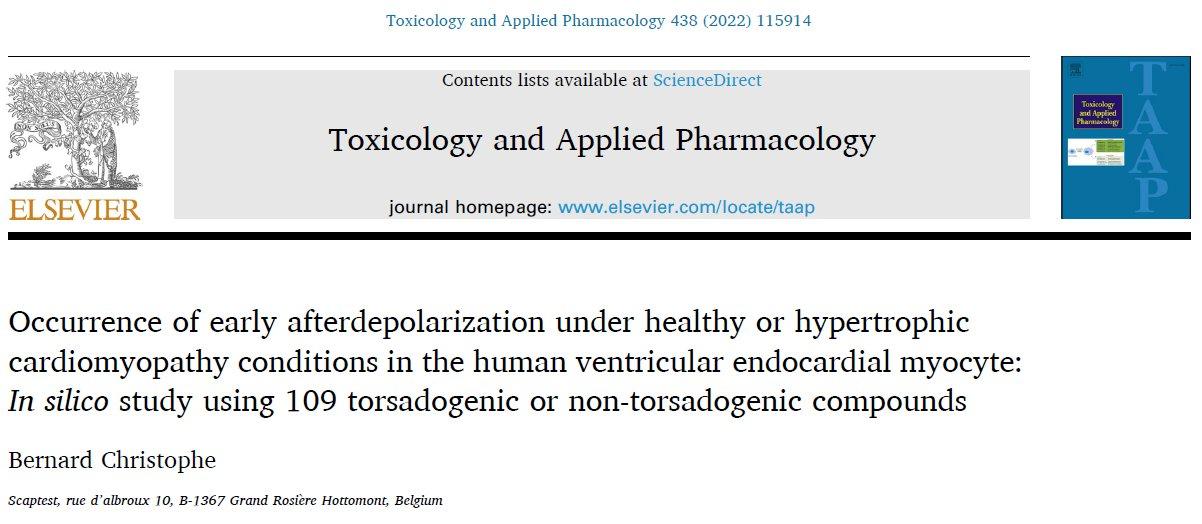
Christophe B. (2022)
Occurrence of early afterdepolarization under healthy or hypertrophic cardiomyopathy conditions in the human ventricular endocardial myocyte: in silico study using 109 torsadogenic or non-torsadogenic compounds
Toxicology and Applied Pharmacology, 438: 115914 PMID: 35150662
https://www.sciencedirect.com/science/article/abs/pii/S0041008X2200059X
The goal of the CiPA initiative (Comprehensive in vitro Proarrhythmia Assay) was to assess a more accurate prediction of new drug candidate proarrhythmic severe liabilities such as torsades de pointes, for example. This new CiPA paradigm was partly based on in silico reconstruction of human ventricular cardiomyocyte action potential useful to identify repolarization abnormalities such early afterdepolarization (EAD), for example. Using the ToR-ORd algorithm (Tomek-Rodriguez-O'Hara-Rudy dynamic model), the aim of the present work was (i) to identify intracellular parameters leading to EAD occurrence under healthy and hypertrophic cardiomyopathy (HCM) conditions and (ii) to evaluate the prediction accuracy of compound torsadogenic risk based on EAD occurrence using a large set of 109 torsadogenic and non-torsadogenic compounds under both experimental conditions. In silico results highlighted the crucial involvement of Ca++ handling in the ventricular cardiomyocyte intracellular subspace compartment for the initiation of EAD, demonstrated by a higher amplitude of Ca++ release from junctional sarcoplasmic reticulum to subspace compartments (Jrel) measured at EAD take-off voltage in the presence vs. the absence of EAD initiated either by high IKr inhibition or by high enough concentration of a torsadogenic compound under both experimental conditions. Under healthy or HCM conditions, the prediction accuracy of the torsadogenic risk of compound based on EAD occurrence was observed to be 61 or 92%, respectively. This high accuracy under HCM conditions was discussed regarding its usefulness for cardiac safety pharmacology at least at early drug screening/preclinical stage of the drug development process.
https://doi.org/10.1016/j.taap.2022.115914
- 5 -
Crumb W.J. Jr & Christophe B. (2020)
A risk profile of fenspiride using ion channel data and in silico action potential modeling
Journal of pharmacological and toxicological methods, 105, 38
https://doi.org/10.1016/j.vascn.2020.106793
Safety Pharmacological Society / Barcelone / September 23-26, 2019 - Poster 100
Recently, the marketing authorization for fenspiride containing products has been suspended in the EU due to reports of QT prolongation and torsade de pointes. As indicated in the Public Assessment report for Fenspiride, a total of 5 cases of QT prolongation including 3 cases of torsade de pointes were reported since the marketing of fenspiride. Most of these cases were in patients which had known or suspected risk factors for QT prolongation or arrhythmias (e.g. congenital LQT) or in patients taking other QT prolonging drugs or doses of fenspiride well above therapeutic. The goal of the present study was to characterize the effects of fenspiride on 3 ion channels which are known to play an important role in QT prolongation: hERG, late Nav1.5, and Cav1.2. Evaluating drugs against these ion channels and modeling with in silico action potential models is part of the new CiPA paradigm. In addition, we wanted to define the concentration-dependent risk of QT prolongation and arrhythmias associated with fenspiride. Using QT Fingerprinting methodology, fenspiride is predicted to be associated with concentration-related increases in Qtc. However, as indicated by the in silico action potential modeling, fenspairide was not associated with an arrhythmic markers (EADs) under healthy conditions. Fenspiride was associated with EADs in models of LQT3, congestive heart failure, and hypertrophic cardiomyopathy. This study shows for the first time the effects of fenspiride on hERG, late Nav1.5, and Cav1.2 recorded at physiologic temperatures and the associated arrhythmic risk profile of fenspiride. The results suggest that in healthy patients, while there may be some degree of QTc prolongation, there is no indication of arrhythmic events. The risk of arrhythmic events is predicted to increase when various cardiovascular risk factors are present.
- 4 -
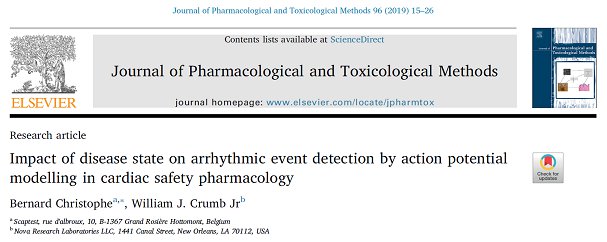
Christophe B. & Crumb W.J. Jr (2019)
Impact of disease state on arrhythmic event detection by action potential modelling in cardiac safety pharmacology
Journal of pharmacological and toxicological methods, 96, 15-26, PMID :30580044
https://doi.org/10.1016/j.vasc
The use of in silico cardiac action potential simulations is one of the pillars of the CiPA initiative (Comprehensive in vitro Proarrhythmia Assay) currently under evaluation designed to detect more accurately proarrhythmic liabilities of new drug candidate. In order to take into account the variability of clinical situations, we propose to improve this method by studying the impact of various disease states on arrhythmic events induced by 30 torsadogenic or non-torsadogenic compounds. In silico modelling was done on the human myocytes using the Dutta revised O'Hara-Rudy algorithm. Results were analysed using a new metric based on the compound IC50s against the seven cardiac ionic currents considered to be the most important by the CiPA initiative (IKr, IKs, INa, INaL, IK1, Ito, ICaL) and the minimal rate of action potential voltage decrease calculated at the early-afterdepolarization (EAD) take-off membrane voltage (Vmin).The specific threshold at which each torsadogenic compounds induced EAD, was exacerbated by the presence of cardiac risk factors ranked as follows: congestive heart failure?>?hypertrophic cardiomyopathy?>?cardiac pause?>?no risk factor. Non-torsadogenic compounds induced no EAD even in the presence of cardiac risk factors. The present study highlighted the impact of pre-existing cardiovascular disease on arrhythmic event detection suggesting that disease state modelling may need to be incorporated in order to fully realize the goal of the CiPA paradigm in a more accurate predictability of proarrhythmic liabilities of new drug candidate
DOI : 10.1016/j.vascn.2018.12.004
- 3 -

Crumb W.J. Jr, Christophe B. & Shah R.R. (2017)
Impact of disease state on arrhythmic event detection using APD modeling
Journal of pharmacological and toxicological methods, 88 part 2 : 205
https://www.sciencedirect.com/science/article/pii/S1056871917303489
Safety Pharmacological Society, Japanese Safety Pharmacology Society and Canadian Society of Pharmacology and Therapeutics joint meeting / Vancouver / September 17-21, 2016
The goal of the CiPA paradigm is to allow the preclinical detection of not simply drug-associated QTc prolongation but also proarrhythmic events. However, it is well known that the incidence of the drug-associated event of interest, torsades, is relatively rare. We explored, using in silico action potential modeling, the influence of various underlying cardiac risk factors (heart failure (HF) and ventricular hypertrophy (VH)) on the incidence of proarrhythmic events (e.g. early afterdepolarizations, EAD). At a pacing rate of 1Hz, under normal conditions, dofetilide (0.1-3nM) was associated with a maximal increase in APD90 of 70%, without EADs. Free plasma concentrations of ≈ 2nM have been associated with a 74% increase in QTc and no torsades in healthy volunteers. In contrast, under HF and VH conditions, EADs were observed beginning at 2nM. Similarly, quinidine (0.3-5.4mM) was only associated with EADs at the highest concentration examined under normal conditions but under diseased conditions, EADs were observed at all concentrations above 0.3mM. The non-torsadogenic drugs verapamil and ranolazine were also examined. APD90 prolongation with verapamil (0.005-0.5mM) was modest, approximately 22-40% at 0.5mM, and under no conditions were EADs observed. Ranolazine (0.575-23mM) was associated with a 59-72% increase in APD90 at 23µM but EADs were only observed in VH conditions and only at the highest concentration tested. These results provide mechanistic support for the impact of pre-existing cardiovascular disease on arrhythmic events and suggest that in order to fully realize the goal of the CiPA paradigm, disease state modeling may need to be incorporated.
https://doi.org/10.1016/j.vascn.2017.09.121
- 2 -
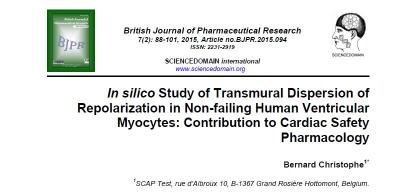
Christophe B. (2015)
In silico study of transmural dispersion of repolarization in non-failing human ventricular myocytes: contribution to cardiac safety pharmacology
British journal of pharmaceutical research, 7(2), 88-101 now Journal of Pharmaceutical Research International 7(2), 88-101
https://journaljpri.com/index.php/JPRI/article/view/551
Aims: To investigate the putative usefulness of the in silico determination of transmural dispersion of repolarization (TDR) for early cardiac safety pharmacology. Methodology: TDR was calculated as the difference between epicardial-midmyocardial action potential duration (APD95) determined in non-failing human ventricular myocytes using the O’Hara-Rudy dynamic algorithm. The role of each ionic current in TDR was investigated by modifying its conductance in the algorithm. The effects of each tested drug on TDR were studied by reducing the IKr, INa and ICaL conductances in the algorithm by a scaling factor which is a function of the IC50 of the drug for IKr, INa and ICaL ionic currents and the maximal effective free therapeutic plasma concentration (EFTPCmax) of the drug. Results: Our simulations showed that TDR was increased by a preferential midmyocardial APD95 prolongation which was induced by net repolarising current reduction via IKr or IKs inhibition and/or ICaL or INaL activation. Drugs’ effects on TDR were in good agreement with their torsade de pointes (TdP) risk according to the CredibleMeds or the Redfern classifications: most torsadogenic tested drugs induced a TDR increase via IKr vs. ICaL and/or INa selective inhibition; while most nontorsadogenic tested drugs induced a TDR decrease via ICaL vs. IKr and/or INa selective inhibition. Conclusion: Based on computer simulations within the human situation, the present study identified the effects of various cardiac ionic currents on TDR amplitude and suggested that in silico study of drugs’ effects on TDR could be informative for early cardiac safety pharmacology.
DOI : 10.9734/BJPR/2015/17850
- 1 -
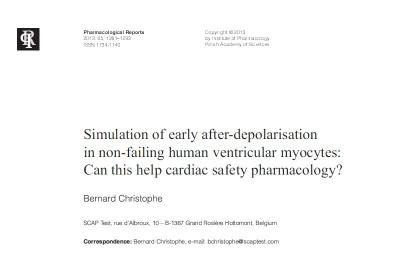
Christophe B. (2013)
Simulation of early after-depolarisation in non-failing human ventricular myocytes: can this help cardiac safety pharmacology?
Pharmacological reports, 65(5): 1281-1293, PMID: 24399724
http://www.if-pan.krakow.pl/pjp/pdf/2013/5_1281.pdf
Background Identified as being the primary mechanism involved in the induction of torsades de pointes (TdP), early after-depolarisation (EAD) formation is an important parameter in cardiac safety pharmacology. Easily observed experimentally at the cellular or tissue level, EAD can also be simulated by computer algorithms using animal or human models. During the last decade, confidence in these algorithms has greatly increased. We investigated the putative usefulness of EAD simulation for cardiac safety pharmacology. Methods EAD simulations were performed in non-failing human ventricular myocytes using the O’Hara-Rudy dynamic model. The role of each cardiac current was investigated by modifying the amplitude of its activity in the model. Prediction of EAD induction by drugs was based on the ratio of their 50 % inhibitory concentration values for various cardiac ionic currents to their maximal effective free therapeutic plasma concentration (EFTPCmax). Results In the ventricular endocardial myocytes, EAD was only induced by at least 85 % inhibition of the rapid delayed rectifier K+ current (IKr). The other currents can either induce or prevent EAD under sub- (80 % IKr inhibition) or up-threshold conditions (87 % IKr inhibition) of EAD. The study of the ability of drugs to induce EAD resulted in a classification which was in agreement with the TdP risk classification. Conclusion Based on EAD computer simulation within the human situation, the present study identified the role of various cardiac currents in the EAD formation and suggested that prediction of EAD formation can be useful for early cardiac safety pharmacology.
DOI : 10.1016/S1734-1140(13)71486-5
